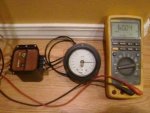Actually, he was quoting me when discussing the jumper...and it was actually my typo (see post number 40). My post should have read " cut the buss bar that connected T10, T11, and T12 together and ran the jumper from T12 to T2"
I would correct it, but it appears that I cannot edit a post that old. So, don't connect a jumper to T3!
It seems that a majority of the MEP's have their buss bars on the bottom of the reconnection board. Most people leave the bar riveted on the underside of the board, and cut it in place with a dremel.
Thanks for the clarification--that's what I figured but just wanted to sure. Now I've reached a minor "all-stop". Got the bus bar off & cut between T11 & T12...reinstalled bus bar, reconnected T13 wire, T10 wire and then began looking at T11 for the original wire connection & then to connect the two "new" wires from T8 & from T12. When I looked at the T8 terminal there are two wires connected--an ~10 gauge size with a small band labeled "8" and then a smaller (maybe 16 or 18 gauge) labeled as per video (X8A16B). By process of elimination I will assume the ~10 gauge wire (with the #8-marked band) is wire # X8HH16B. Please advise if that's a safe bet. Haven't looked at T12 to T11 wire move...doing one change at a time....thanks...
BTW, wrt the bus bar cutting, I went ahead & drilled out the 3 brass rivets, removed the bar & made the cut in the shop, away from the wiring. My air cutoff tool has a 4" dia blade--figured I'd cut a few wires in the process so played it safe...

Update--calling it a day here but didn't want folks to panic based on my confusion related to the wire change from T8 to T11...I had mistakenly moved the original T8 wire to T11, thinking it was the wire #X8HH16B--this wire had gotten lost in the birds nest under the board. Anyway, I located wire X8HH16B & connected it to T11. Also restored the "8" wire back to its proper connection at T8.
So as a final check on the new configuration of the wiring as per instructions, here is what the terminals affected have connected:
T2-- now has the newly installed 6 gauge jumper wire plus (3) existing wires (2 ~10 ga & 1~ 16 ga), for a total of 4 wires connected.
T3-- now has XA16B plus the (3) existing wires (2 ~ 10 ga & 1~ 16 ga), for a total of 4 wires connected.
T8-- now has it's original ~10 ga wire connected. One wire only on this terminal.
T11-- now has it's original ~10 ga wire connected, plus "new" wires X8HH16B & X12EG16N, for a total of 3 wires connected.
T12-- now has the newly installed 6 gauge jumper wire plus it's original ~10 ga wire connected, for a total on 2 wires connected.
Hopefully all this makes sense to anyone reading it and familiar with the mod. Won't actually attempt a light-off until Friday p.m.....if anyone sees anything fishy in my summary, please send up a flare!





